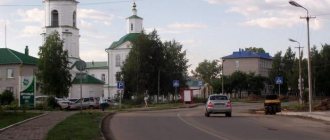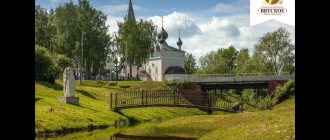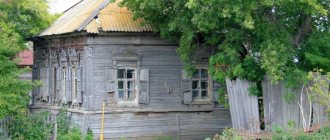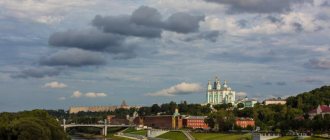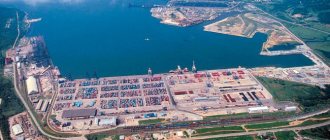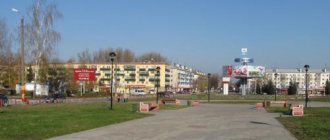- Where are you driving?
In Salt of what? - Sol-vy-che-godsk, I’m going to Solvychegodsk.- What are you going to do there, in this wilderness?
- Live…
Thus began my new, completely different life, somewhere between the river, forests and swamps, in the once great town of Solvychegodsk.
It is impossible to fall in love with this place at first sight; you need to feel this place, understand it, and become involved in the history that is woven into the streets of Sol Vychegodskaya. That is why you need to stay there for at least two days. Dedicate the first day to a trip to the museum, where you will be introduced to the great past. But the next time, you just need to wander through the quiet streets, catch that same aura, feel the great power and steadfastness of the Russian North and at the same time comprehend everything that you have learned over the past day. This is how I got to know Solvychegodsk for the first time.
- Ferry to Solvychegodsk
- Annunciation Cathedral in Solvychegodsk
- The Stroganovs in the history of Solvychegodsk
- Merchants in the history of Solvychegodsk
- Solvychegodsk – a place of exile
- Seasons in Solvychegodsk
- Vychegda River
Ferry to Solvychegodsk
Now, when I walk around the city, I remember my first visit with a smile. Until this day, I only knew about ferries, which is how people get to the city in the summer, only from Soviet films, where a wooden ferry floated along the river, moving along a stretched rope. And when I saw a barge with a boat, I asked: “Where is the ferry?”
Ferry station on Vychegda
“So that’s who he is,” they answered me.
-Where is the raft and rope?
– Well, we live in the 21st century, such ferries are a thing of the past.
Administrative and municipal status
As part of the structure of administrative units, it is included in the Kotlas district as a city of regional significance of Solvychegodsk
.[1] As a municipal entity, the city of district significance of Solvychegodsk, together with the territories of Pacheozersky, Peschansky, Solvychegodsky, and Kharitonovsky Selsovets (which constitute, respectively, twenty-five, twelve, forty and sixteen rural areas, a total of 93 rural settlements) of the Kotlas district is included to the Kotlas municipal district as
the Solvychegodsk urban settlement
.[5]
Annunciation Cathedral in Solvychegodsk
I remember that day it was cloudy, autumn, and nasty rain was drizzling. But suddenly the sun came out and the huge Annunciation Cathedral lit up on the opposite bank. How magnificent it was: huge, immersed in the golden foliage of autumn birches, it amazed with its grandeur. I especially remember the contrast of white simple forms against the background of a dark, almost purple sky. This sight took my breath away. I think everyone who takes a ferry for the first time experiences something similar, although I experience this admiration almost all the time.
The stunning Annunciation Cathedral
The Annunciation Cathedral in Solvychegodsk has a very interesting history. It was built in honor of the Annunciation holiday in the 16th century by the famous and truly great innovators of Russia - the eminent people the Stroganovs.
Now the cathedral houses the Solvychegodsk Historical and Art Museum, or rather, the temple is one of the objects of the museum, and there are seven objects in total. The cathedral was rebuilt several times, which is why its architectural image is so mysterious and unusual.
Royal Doors of the Annunciation Cathedral
In-wall passages from one hall to another, stone bags in the basements and many voids left after the reconstruction gave rise to many legends and myths, which they will definitely tell you about during the tour.
is a classic example of ancient Russian architecture; the walls inside the temple are completely covered with paintings on various biblical themes. Honestly, it’s quite unexpected to see such splendor somewhere in the forests of the Arkhangelsk region. One of the main exhibitions of the museum, dedicated to the legacy of the Stroganovs, is also located here.
In the halls of the Solvychegodsk Historical and Art Museum
Magnificent examples of silversmithing, icon painting, and gold embroidery production, which were once created in the Stroganov workshops in the 16th-17th centuries and are famous far beyond the borders of Russia. When you look at these objects, you involuntarily draw a parallel with modern masters, of whom, by the way, there are not so many, and you wonder how, without power tools, 3D printers, or computer technology, people created such masterpieces. Until now, the warmth of the masters’ hands warms the soul of everyone who looks at these exhibits.
LiveInternetLiveInternet
There is something artificial, unreal in the names of cities, stumped with a stump -sk: Kursk, Tomsk, Borisoglebsk... You understand with your mind that this was an adjective to some already lost noun... They didn’t save, they didn’t save. What did their names sound like before? Just a hint - in rare names: Tsarskoe Selo, Sergiev Posad, Staroe Gorodishche, Gus Khrustalny... What's bad? And it’s not bad, it’s just the law of saving language resources, the desire for brevity... But along with part of the name, part of the history also faded into oblivion as a kind of atavism, already unnecessary for the city with a truncated name. Such is the fate of Solvychegodsk—Soli-Vychegodskaya, as it was called in the old days.
Solvychegodsk is a small provincial town in the Arkhangelsk region. And you won’t immediately find it on the map. Trains don’t go there, planes don’t fly, the bus only goes to the shore of Vychegda. And then the ferry is the main gate of the city.
A small private bus from the Kotlas station takes people to the shore. The driver and the enormous conductor are family. He drives the bus, she fills it:
- Girls, where are you going? Yes, you are ours. Come on, come on, faster! Everyone exhaled together and entered. Here with a baby, you need to take it. Grandma, are your eggs raw? Well, you'll bring scrambled eggs. How many are there? Thirty?! Well, great scrambled eggs. You climb back, you still have a long way to go. Is there any glass in the suitcase? Place someone on it or sit down yourself...
The bustle, fuss and hubbub die down as soon as the city of Kotlas releases the bus from itself. Now the road winds through the forests, stops are rare. Slender pine trees along the roadsides, rare houses, signs... On every bump, the poor passengers gasp or quack in unison - depending on whether they take off or sharply tilt to the side...
Here is the shore. It gently slopes down to the Vychegda River. Behind it is Solvychegodsk. It is almost invisible behind the coastal bushes and trees. There is a temple just on the shore. Extraordinary beauty.
There is no pier or landing stage. The black road goes straight into the water. A huge ferry hits the shore. People, already accustomed to such a crossing, disciplinedly line up along the left side of the road, letting colorful and assorted cars pass, hurrying to Kotlas. But with the last car leaving, order ends. People rush to the ferry to find a seat, not paying attention to the maneuvering cars also rushing to the ferry.
The ferryman hesitates - will another vehicle or person appear? Late for the ferry - half an hour in the icy wind. No, latecomers are not visible. The platform slowly undocks from this bank and hurries to the opposite, where everyone is greeted by the majestic cathedral, built to last for centuries by the Stroganov family in their estate, in Solvychegodsk.
The lead waters of Vychegda are swift. The speed of the current can be clearly seen from a piece of paper thrown by someone. A minute later and you can no longer see her in the distance.
The ferry touches the shore next to the temple. The dirt road rises steeply. Underfoot there is gray, sometimes even black sand.
On a hillock there is a dilapidated cash register house, boarded up and squalid. No one has been selling tickets here for a long time: the ferry has its own conductor.
We walk along the sandy road to the hotel. On the way there is a wooden bridge with railings. You look down - it looks like a stream. But this is the Usolka River. Hurries from Salt Lake. Here you will no longer know whether this is the same Uslolka, with which the beginning of salt production on this land is associated, or some other one, because all the salty rivers here are called Usolki. It is also surprising that this stream washed such a deep channel in the sandy soil. From the bridge to the river it will be about five meters.
Here is the hotel. It is located in a former merchant's house, which differs little in appearance from the surrounding buildings: hospital buildings and residential buildings. It's painted with the same paint, and there's the same chain-link fence around it. Through the gate along the wooden walkway we come to the doors, locked with a padlock. And a piece of paper: “For questions regarding settlement, please contact...” and then phone numbers. We call, the administrator comes running:
- Sorry! We don’t have many tourists now, so what’s the point of sitting idle in an empty hotel? Here I am digging in the garden. And I live nearby...
She unlocks the doors, letting us into the cluttered hallway. Some junk was dumped haphazardly. It turns out that these are the remains of the utensils of merchants who lived in the house before the revolutionary changes. They did the repairs and found them. The hand did not rise to throw it away. Until they figured out what to do with it, they left here.
The hotel inside is wonderful. European-quality renovation, design, plumbing, furniture... And in the entire two-story building we are alone!
“If you want, I’ll turn on the microwave for you in the bar,” the administrator offers. — There is hot water and heating. Just don't smoke in the rooms - there is a fire alarm...
- Why is such beauty still empty?
- This is a temporary phenomenon. The Prutkovsky festival will begin now - all downtime will be more than paid for.
We settle into the room. The view from the window is a grassy yard, a wooden house worthy of a playground.
Then we will look around it, and along the way we will see henbane bells in the grass, known from drawings of poisonous plants.
And from the window there is a view of Solvychegodsk sunsets.
Well, we're settled. It's time to get acquainted with the city.
Solvychegodsk is not one of the oldest. It was founded, according to historians, by settlers from two neighboring settlements - the more ancient Chernigov, which burned down in 1546, and Vybor, swept away by a river flood in 1586.
Even before the foundation of the Salt of Vychegda, the inhabitants of Chernigov were well aware of the salt lake and the Usolka river, where their cattle went to feast on salt and where the most enterprising inhabitants began to build the first brewhouses “for boiling salt.” These breweries actually became the core of the future large industrial and commercial center - Sol Vychegda. And this began from the moment when active and enterprising people, the Stroganovs, appeared here. The very ones without which it is impossible to imagine Russia of the 17th-19th centuries. Russia owes Stroganov the conquest of Siberia. In troubled times, the tsar’s treasury was supported by the Stroganovs’ money. Since 1722 the Stroganov barons, since 1761 - counts. Stroganov palaces, Stroganov schools and even beef Stroganoff - everything is connected with their family...
According to legend, the Stroganovs descend from the Murza of the Golden Horde, who, during the time of Dmitry Donskoy, the Tatar Khan ordered “to be tied to a pole, his body to be cut up on it, and then, chopped into pieces, scattered” because he was baptized under the name of Spiridon and went at the head of the Russian army against his fellow tribesmen. That’s why the Stroganovs were called that way, from the word “plane”...
The first documented Stroganov, the grandson of Spiridon, Luka Kuzmich, lived in Veliky Novgorod and owned great wealth. He is famous for the fact that in 1445 he ransomed Grand Duke Vasily the Dark from captivity, and “Tsar Mahmet took 200,000 rubles from him (Vasily), but God knows otherwise.”
Before the ruin of Novgorod, the Stroganovs moved to Podvinye. From there two branches emerged - Solvychegda and Totem.
The ancestor of the Vychegda Stroganovs, Ioannikiy, or Anika (1497-1570), is an outstanding personality in all respects. Being a black-growing peasant by birth, he managed to become the main creditor of the Russian state, a man in whose hands would be a treasury many times larger than the state treasury.
He started with varnitsa. He quickly made initial capital from salt, and then began to develop other branches of the Stroganov Empire: he established trade with the Trans-Ural foreigners, buying from them “soft and expensive junk,” that is, furs, for next to nothing. According to the grant of 1574, the Stroganovs were allowed to mine “copper or tin ore, lead ore and flammable sulfur in the Cis-Ural region and beyond the Urals, where they will find those ores for testing...”. Along with the salt, fur and iron-blowing industries, the Stroganovs “started” blacksmith production in the North, were engaged in wholesale and retail trade in red fish, and resold goods purchased from foreigners in Arkhangelsk (then Pur-Navolok). At the fairs they traded in Siberian furs, firewood, which was required in huge quantities for salt production, bread, which was always valued in the North, and vegetables brought from the southern regions of the country. Chroniclers said that their wealth “grew by leaps and bounds.”
At the same time, Anika was modest in everyday life: legends say that he spent his entire life wearing his grandfather’s fur coat. Being a pious and God-loving man, he built churches and made generous contributions to monasteries. In Solya Vychegda, he built a house church - a huge stone Annunciation Cathedral, and this cathedral was equipped with hiding places, basements, and secret passages in thick walls, so that, if necessary, it could become an impregnable fortress, where not only all the Stroganovs and servants, but also most of the posad. In addition, the cathedral was placed on the shore and served as a kind of pier, equipped with signal cannons. This cathedral still welcomes guests and is the hallmark of Solvychegodsk.
And Anika’s house was outstanding. Historians report that it was “an impressive and monumental building of three floors, consisting of several log houses placed side by side under one gable roof. It stood out sharply due to its height among other ordinary buildings. Adjacent to the mansion was a six-story tower about 30 meters high. The lower, basement floor of the mansion had no openings, and the upper ones, on the contrary, were well lit by regularly spaced windows. A two-flight porch with a hipped roof above the lower locker (platform) and with a “barrel” above the second led to the entryway. The picturesque composition of the building was enhanced by another decorative turret placed above the entryway with a hipped roof and a policeman.” All rooms in the choir were very lavishly decorated. In the upper rooms there were large tables “with oak tops”, icons in gold and silver frames, copper, silver and glassware, clocks “German made”, carpets made from the skins of polar bears. There were musical instruments hanging on the walls, and there was even a “parrot cage.”
The maintenance of such a house, diversified activities and continuous construction required a huge number of workers. From business papers on the division of property after the death of Anika Stroganov, it is clear that the number of his courtyard people at that time reached 233 people. The entire household of the Stroganovs in 1570-1571 numbered over 600 people. For them, not far from their house, the Stroganovs built a large courtyard with numerous outbuildings. The entire courtyard complex with mansions, subsequently surrounded by walls, turned into an independent fortified center, a kind of city within a city.
The Stroganovs' courtyard was located in the western part of Solvychegodsk, while in the eastern part there was an administrative and trade center with the voivode's and state courtyards and a green cellar, with customs and loan huts, courtyards of clerks, etc. Here, on the central square, stood a wooden cathedral church Resurrection, two taverns and churchyards.
There was no confrontation between the Stroganovs and the townspeople. Moreover, since 1559, Anika was the all-district zemstvo headman and headed the elected zemstvo court. Apparently, the townspeople trusted him: not only did he get rich, but he also helped others.
True, Anika Stroganov had one passion. He could pay a huge sum for that time for icons or books that he had collected all his life. His enormous wealth made it possible to spend significant funds on the construction of churches and mansions in his estates, for the decoration of which he organized various artistic crafts. In fact, this was the beginning of philanthropy, which distinguished this type of Russian entrepreneurs.
Anika's sons grew up to match their father. Entrepreneurs from God too. The Solvychegodsk lands became cramped for all the Stroganovs. In the towns built along the Kama, Kamgorta and Orel, they began to boil salt in large quantities, sending it up and down the Kama, Chusovaya and Volga - to Kazan, Nizhny Novgorod and other places.
Economic ties for a long time were carried out thanks to the Great Sleigh Road: Moscow - Yaroslavl - Vologda - Totma - Veliky Ustyug - Solvychegodsk, from Solvychegodsk - the village of Burtsa-Bolshoi Dvor on Viledi - Korakino - the village of Kibra on Sysol - Paluz - the village of Uzhga - Gidaevo - Kai- a town on the Kama - Lukhna Kosa - Urolka - Solikamsk and further to Siberia. (What are the names!)
Convinced that matters were in the capable hands of his sons, Stroganov, feeling, as the chronicler writes, “the burden of his old age and the power of diminishment,” took monastic vows under the name of Joasaph in the Pyskorsky monastery. After his death, his ashes were interred in Solvychegodsk, not far from the temple he built.
In fact, it would be worth studying in more detail the phenomenon of Anika Stroganov, his talent as an entrepreneur. There was no equal to him in his time, and there is none now.
His sons lived by common interests and even after the death of Anika and the division of his property, they conducted business mainly together, jointly, which ultimately predetermined the rise of their house in competition with other industrialists and merchants.
During the Polish-Swedish intervention at the beginning of the 17th century, Solvychegodsk remained aloof from military operations for the time being, and the Stroganovs made money by reselling goods and grain at speculative prices. With the accession of False Dmitry I, they acquired even greater power in their domains, having received from him a charter, according to which they could administer judgment over their people themselves. Subsequently, the government of Vasily Shuisky confirmed this charter.
But as soon as the enemy was in the North, the Stroganovs organized military detachments to help Shuisky and loaned him very large sums of money. However, the appearance of Pan Yatsky's three thousand-strong army near Solvychegodsk on January 22, 1613 took the townspeople by surprise. To protect the city, they hastily made a huge hole, several miles long, in the middle of the frozen Vychegda, meeting Yatsky’s troops with fire from cannons and arquebuses. But Vychegda failed, it was frosty - the ice hole froze and did not protect the city. The Poles, Cossacks and Russian “thieves” responded by also opening “brutal shooting”, unable to bear it the townspeople retreated to the Annunciation Cathedral. Yatsky’s “gang,” splitting into three groups, rushed to storm Solvychegodsk, putting the city’s defenders to flight.
Most of the residents fled to their homes to save their property. The Streltsy and the Stroganovs' men took refuge in their well-fortified courtyard. The high, powerful walls of the courtyard with a tine and an earthen embankment looked so impressive and reliable that the interventionists did not dare to storm them. They directed their attack on the wooden fortifications of the fort, behind which the Trinity Posad part of Solvychegodsk was located, and took them. The next day the looting of the city began. The Annunciation Cathedral was especially badly damaged.
Although the Stroganovs, as governors, did not rise to the occasion, the Moscow government appreciated their financial services and assistance from military men, granting them charters in 1610, according to which, in addition to the usual benefits, they received the right to be called “vich.” From now on, Andrei Semenov's son was to be called Andrei Semenovich Stroganov. Thanks to this, the Stroganovs, in the category of guest merchants, occupied a special position as eminent people who enjoyed a number of different advantages. In the 17th century, this was the only surname of eminent people in Russia.
In the middle of the 17th century. Solvychegodsk at that time had a fortified fort with a moat, covering the old part of the city near the Annunciation Cathedral, on the right bank of the Usolka. The fort consisted of taras - square or triangular log houses, covered with earth and stones, with a tine on top of them, and of four carriageway and fourteen blind towers. In 1619, the rest of the city, located on the left bank of the river, was also surrounded by a fort of the same type, with six gate and sixteen blind towers and a moat. About twenty wooden temples rose above the walls and towers of the forts. Some of them had tent tops typical of the North, and three had wedge tops, which gave special expressiveness to the silhouette of the entire building. However, the stone building of the Annunciation Cathedral reigned supreme in the overall panorama of the city.
In the 17th-18th centuries, the city was known for its three fairs - Alekseevskaya, organized before the start of field work (March 7-14), Prokopyevskaya, which was a kind of “brides show” and a place for hiring people to work before the harvest (July 7-10), and Vvedenskaya, held after the harvest (November 20-27).
In the second half of the 18th century, Solvychegodsk, which found itself aloof from trade routes, gradually turned into a quiet and small provincial town.
In the 19th century, Solvychegodsk became a remote and distant city, where the tsarist government exiled political figures. Many Russian revolutionaries served their exile here (Joseph Stalin also served his exile here).
In the 20th century, Solvychegodsk did not even have this status. Now the city-forming enterprises are a museum and a sanatorium, the main balneological factor of which is the noticeably desalinated brine of the Salt Lake and the Usolka River. Previously, there was also a timber industry enterprise here, but it has sunk into oblivion. And the prospects for the sanatorium are not very good: the Koryazhemsky Pulp and Paper Mill was built a little further upstream of the Vychegda River. What kind of resort area can we talk about in such a neighborhood? Along the river, the wind drives flakes of foam from the waste dumped by the plant...
Anika's family branch died out. And although in Kotlas villages there are many people named Stroganov, as local historians say, this is more a sign that the peasants worked for the Stroganovs, rather than belonging to the family. The last representative of this once powerful family - Baroness Helene de Ludinghausen (her grandmother Sofya Vasilchikova, daughter of Olga Stroganova - granddaughter of Sergei Grigorievich Stroganov, left Russia at the end of 1917 along with four daughters. In 1942, one of Vasilchikova's daughters - Ksenia and Baron Andrei de Ludinghausen, a descendant of Russified Germans who lived in Russia back in the 16th century, had a daughter, Helene) lives in France. She established the Stroganov Charitable Foundation... They say she visited Slvychegodsk and admired the temples...
Now let's go for a walk. Look at the city. Is there anything left of the Stroganov empire?
Series of messages “Solvychegodsk”:
Part 1 - Solvychegodsk. The city and its history. Part 2 - Solvychegodsk. Annunciation Cathedral Part 3 - Solvychegodsk. Vvedenskaya Church. ... Part 7 - Solvychegodsk. School of crafts Part 8 - Solvychegodsk. Vychegda and its banks. Part 9 - Solvychegodsk. Why? (story)
The Stroganovs in the history of Solvychegodsk
But all this did not arise out of nowhere; this is where the famous surname pops up - the Stroganovs. The city acquired the severity and severity that is felt in the air thanks to these eminent people. By the way, it must be said that the boundaries of the settlement have hardly changed during the entire existence of Sol Vychegda. The layout has changed a little, the course of the Usolka River has changed, but in general time has stood still here and nothing has changed.
Stroganov mansions
Anika Stroganov, who came into inheritance at the age of 18, began active business activities in the city. Here, on the salt lake, he set up his first salt makers, subduing all the other salt makers. Having become a monopoly in the salt business, the Stroganov family began the development and extraction of iron ore; in addition, they traded furs and had their own scriptorium.
Not forgetting about the spiritual side of their lives, they donate a lot for the construction of churches, for painting icons and making church utensils. Why do they open huge workshops in their yards?
But life goes on as usual, trade routes change. The Stroganovs, already barons, moved closer to the capital at the end of the 17th century, and the life of Solvychegodsk froze for almost a century. The last thing their family leaves behind in the city is the Vvedensky Cathedral in the Baroque style. Ornate, rich, completely unusual at that time, completely outside the canon, which is why they did not want to consecrate the temple for a long time. The cathedral was built by Baron Grigory Stroganov, the same one with whom Peter the Great loved to consult and who had breakfast on a barrel of gold.
Vvedensky Cathedral of Solvychegodsk
And then oblivion came.
Merchants in the history of Solvychegodsk
For about a century, Solvychegodsk lived a calm, sedate life, an ancient way of life without any special changes. In the 19th century, the Khaminov merchants began their activities in the city. Of course, in terms of their scope they cannot compare with the Stroganovs, but their activities clearly served as an example for them. After this merchant dynasty, many stone buildings in the classical style of the 19th century have been preserved in the city. Almost the entire center is built by the Khaminova merchants - the organizers of an almshouse, a gymnasium, vocational and secondary schools and zealous philanthropists. The museum has a separate complex located in one of the Khaminovs’ residential buildings. Here you can hear the story of how their family came to be.
House of merchants Khaminovs
Another building that does not fit into such a remote place is the house of the Pyankov merchants. If the architecture of the Khaminovs’ time were simple two-story buildings, then the Pyankovs’ house was a luxurious palace-style building with columns and two wings. But the fate of the house is quite sad, as is well written in the article “Thirty-three misfortunes of the Pyankov house.”
House of the Pyankov merchants
A fire, the death of the owner, litigation during the division of property, all these vicissitudes led to the fact that the house never became residential. The owner of the house sold the house for administrative premises to pay off her debts. Only after this did life begin to boil in the Pyankovs’ house: in Soviet times, the house had a drama theatre, a cinema, a resort, an evacuation hospital, a house of pioneers and many more interesting things. This is a completely different story, but quite interesting and requires a separate story.
Recommendations
Notes
- ^ a b c d f f
State Committee of the Russian Federation on Statistics.
Committee of the Russian Federation for Standardization, Metrology and Certification. No. OK 019-95 January 1, 1997 “All-Russian classifier of objects of administrative-territorial division. Code 11 227 504”, Ed. changes No. 278 / 2015 dated January 1, 2016. (State Committee of the Russian Federation on Statistics. Committee of the Russian Federation on Standardization, Metrology and Certification. No. OK 019-95 January 1, 1997 Russian Classification of Administrative Objects (OKATO). Code 11 227 504
As amended by Amendment No. 278/2015 dated January 1, 2016). - ^ a b c Encyclopedia of Russian Cities
. Moscow: Great Russian Encyclopedia. 2003. p. 432. ISBN 5-7107-7399-9. - ^ a b
Federal State Statistics Service of Russia (2011).
“All-Russian Population Census 2010. Volume 1" [All-Russian Population Census 2010, vol. 1]. All-Russian Population Census 2010 [All-Russian Population Census 2010]
(in Russian). Federal State Statistics Service. - "26. The size of the permanent population of the Russian Federation by municipalities as of January 1, 2022.” Federal State Statistics Service. Retrieved January 23, 2022.
- ^ a b c d
Law No. 258-extra-OZ - "On the calculation of time." Official Internet portal of legal information
(in Russian). June 3, 2011. Retrieved January 19, 2022. - Post office. Information and computing center of OASU RPO. ( Post office
).
Search for postal facilities ( Search for postal facilities
) (in Russian) - Federal State Statistics Service of Russia (May 21, 2004). “The population of Russia, the constituent entities of the Russian Federation as part of federal districts, urban settlements, urban settlements, settlements, settlements of 3 thousand or more people.” [Population of Russia, its federal districts, federal subjects, districts, urban settlements, rural settlements - administrative centers, rural settlements with a population of more than 3000 people] (XLS). All-Russian Population Census of 2002 [All-Russian Population Census of 2002]
(in Russian). - “All-Union Population Census of 1989. The actual population of union and autonomous republics, autonomous regions and districts, territories, regions, urban settlements and villages. Appendix to the resolution of the administration of the Arkhangelsk region of 08/13/1998 N207” (in Russian). Pravoteka.ru. Retrieved October 19, 2011.
- “Order of the Ministry of Culture of the Russian Federation, Ministry of Regional Development of the Russian Federation dated July 29, 2010 N 418/339 Moscow” On approval of the list of historical settlements” (in Russian). Russian newspaper. September 29, 2010. Retrieved October 24, 2011.
- State Institution “Solvychegodsk Historical and Art Museum” (in Russian). Russian Network of Cultural Heritage. Retrieved May 26, 2011.
Sources
- Arkhangelsk Regional Assembly of Deputies. Regional Law No. 258-extra-OZ of September 23, 2004 “On the status and boundaries of the territories of municipalities in the Arkhangelsk region”, as amended. Regional Law No. 224-13-OZ of December 16, 2014 “On the abolition of certain settlements of the Solovetsky District of the Arkhangelsk Region and amendments to Article 46 of the Regional Law “On the status and boundaries of municipalities in the Arkhangelsk Region””. Came into force on the date of official publication. Published: “Volna”, No. 38, October 8, 2004 (Arkhangelsk Regional Council of Deputies. Regional Law No. 258-extra-OZ dated September 23, 2004 On the status and boundaries of the territories of municipalities of the Arkhangelsk Region
As amended by the Regional Law dated 16 December 2014 No. 224-13-OZ.
On the abolition of several settlements in the Solovetsky district of the Arkhangelsk region and on amendments to Article 46 of the regional law “On the status and boundaries of the territories of municipalities in the Arkhangelsk region"
. Valid from the date of official publication.) .
Solvychegodsk – a place of exile
In the 19th century, Solvychegodsk became a place of political exile. Quite a lot of interesting personalities were sent here. The most famous are Pushkin’s uncle, Pavel Hannibal, who loved to show off, shoot at six in the morning from a signal cannon and generally annoyed the local residents, for which he was transferred, due to numerous complaints from the townspeople, to Solovki. And also Joseph Dzhugashvili (Stalin), it’s not worth talking about him, he’s a well-known media personality. While serving his exile here, he escaped by dressing in a woman's dress. You can learn more about this side of the city’s history in another museum building where young Koba lived. The “Museum of Political Exile” houses an exhibition dedicated to political exiles.
Kuzakova's house, where Stalin served his exile
Seasons in Solvychegodsk
You can come to Solvychegodsk at any time. In autumn, everything dresses in orange-golden shades. The sky becomes leaden, already low, as if it falls on the shoulders of the buildings. The still bright sun provides the last warmth before the long frosty winter.
Solvychegodsk in winter
In winter, the city is very beautiful, everything is white, trees covered in frost sparkle in the sun, the dark water in the river contrasts sharply with the white snow, leaving a feeling of some kind of power of nature.
In summer, the city is surrounded by greenery, children frolic on the river, the most visited place is the Razgulyaevsky (duck) bridge, where you can feed the permanent residents of the Usolka River - ducks. By the way, some birds do not fly away until December. They are constantly fed, so they are not afraid of people and immediately swim as a flock as soon as someone stops on the bridge.
Solvychegodsk in summer
But spring is not the best period for tourists; at the end of March - beginning of April, the city goes through the stage of transformation from a cocoon into a butterfly. The roads are “falling”, slush, puddles, the snow becomes dark. The only joy is that this does not last long and by the end of April everything begins to live again. Many people start going to the river, waiting for the ice to break up. It’s an epic spectacle, I’ll tell you, when huge blocks of ice, bumping into one another, float down the river with a crash and noise, pushing each other to the shore. And in May the Vychegda flood begins.
Solvychegodsk in spring
